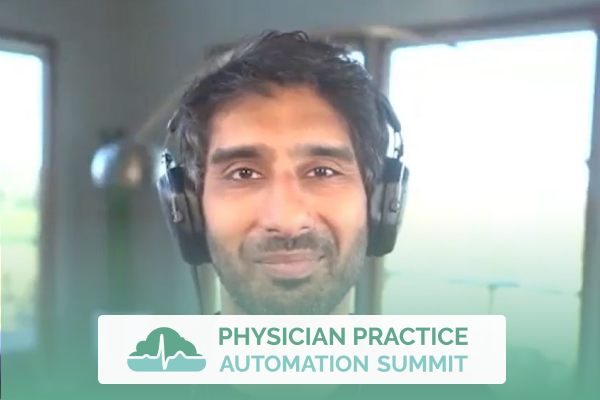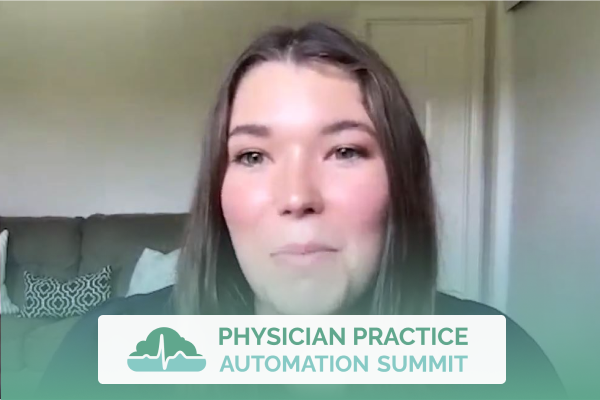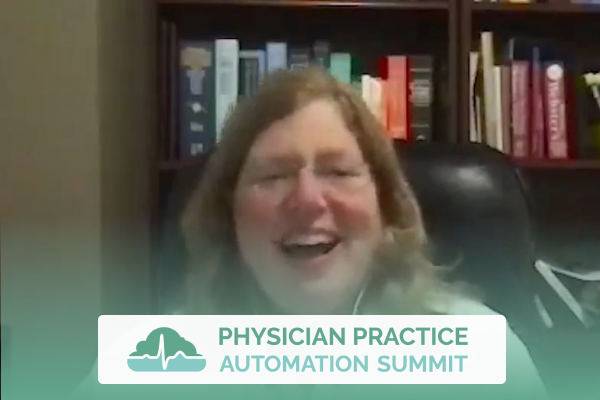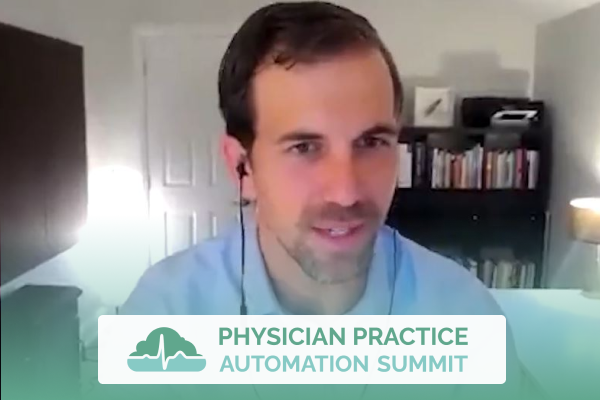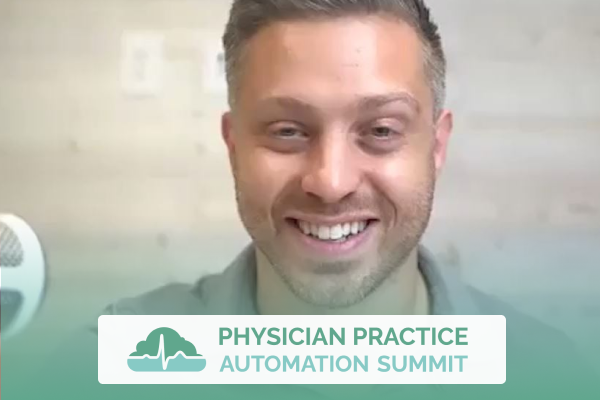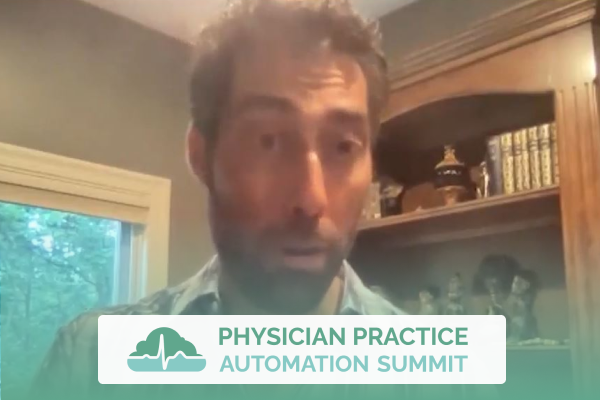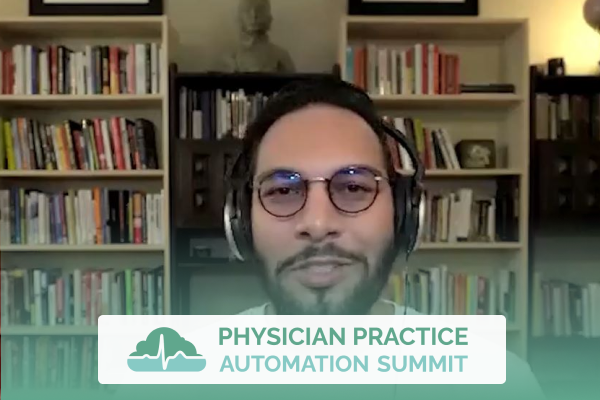Join the discussion below

Dr. Ruan is the Founder and CEO of Texas Center for Lifestyle Medicine. He devotes his career in practicing and building systems that allow for efficient delivery of healthcare. He is a board certified internal medicine physician but also have advised with companies to improve their workflow, company culture, marketing,... Read More
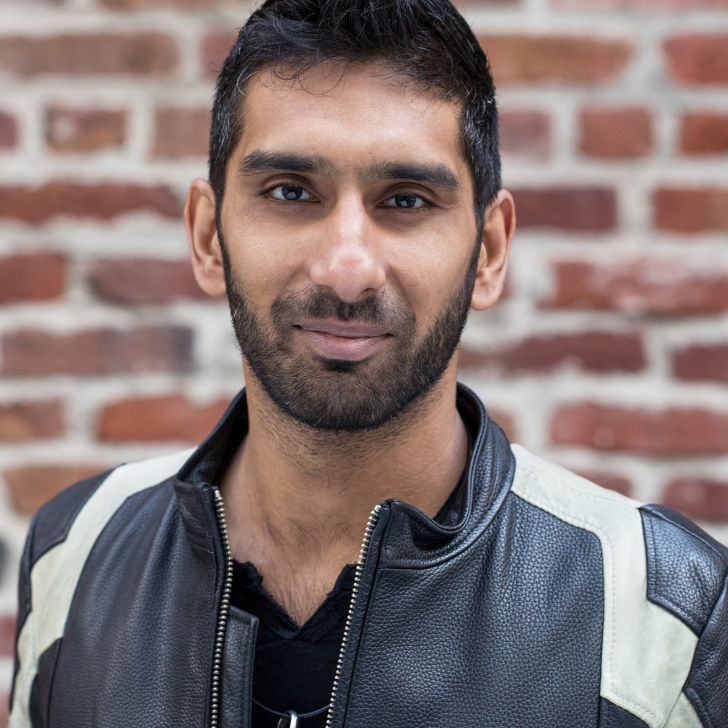
Rahul is the founder and CEO of Superhuman, the fastest email experience in the world. Users get through their inbox twice as fast — and many see Inbox Zero for the first time in years! Previously, he founded Rapportive, the first Gmail plugin to scale to millions of users. Rapportive... Read More
Cheng-Huai Ruan, M.D.
How many of you have such a love- hate relationship with email? Email, I think is the one thing that’s really congruent for most medical practitioners. We use it, we love it, we hate it and there’s a lot of different nuance to email, but I came across this platform called Superhuman and it was something I came across on Instagram. I clicked the button, I downloaded it and decided to just take it for a ride and lo and behold, I did not realize that 20 minutes was gonna absolutely change my productivity in my life. So it’s something I really wanna share with you guys, because it’s such a simple concept, but it goes far deeper than you can possibly imagine to improve your outcomes, improve your productivity and have less stress for the day by hacking your emails. So today I have Rahul, who is the Founder and CEO of Superhuman and it’s the fastest email experience in the world and it gets to inbox twice as fast, for me, it’s probably three times as fast. And I think that this is a topic that’s not touched on before, but technology has the ability to limit you or has the ability to prop you up. And we’re gonna talk about the technology that really propped me up when it comes to email, inboxes and my own sanity. Yeah, welcome to the summit, I’m so happy to have you here.
Rahul Vohra
Awesome, thank you for having me.
Cheng-Huai Ruan, M.D.
Yeah, so as I was saying in your introduction is that I think a lot of doctors kind of burnt out at the email system , so I honestly wasn’t expecting to interview someone who designed an entire email platform until it absolutely changed my life. My wife can tell you that right now she’s outside the door. And so let’s just kind of get into really quick, I think a lot of doctors get so burdened with communication because I’ll tell you why, right? So yes, we have email and then a lot of doctors in the United States have something called secure messaging which is behind a secure platform and then there’s texting and then there’s secure texting and then so right now there’s just so many forms of communication and we feel like we’re just being lambasted with different items to do and doctors also sits on boards of companies and medical directors, so just email alone becomes an absolute gargantuan stressor, like when we kind of open in the morning and stuff like that. How do you think you want to address the automation of all of these different things into a simple format just to make it just not stressful. What are your tips here?
Rahul Vohra
Well, we have quite a few. Every week we welcome hundreds of new customers to Superhuman and through tens of thousands of personalized onboardings, I’ve actually seen firsthand how some of the most productive people in the world get through hundreds if not thousands of emails a day. And so as you were asking that question, what I came to mind was was the nine things that we tend to teach people. So, number one, I would say trash your folders, labeling emails or dragging them into folders can feel oddly unsatisfying, but if you’re filing emails manually, you’re actually wasting colossal amounts of time, it actually takes longer to find an email by a folders than it does in a search. In fact, you’ll save more than an hour per week, if you simply stop manually filing emails or applying labels. So the next time you were about to file an email, resist that urge, let your email client do the hard work for you to automate triaging and of course you can use Superhuman to do that as one of the things that it makes very easy. So I would say is tip number one.
Cheng-Huai Ruan, M.D.
That is so counterintuitive because I was obsessed about labeling everything and as email comes in, I’ll say, oh here’s red for this company or this thing that’s here, right? But I think after using Superhuman, I think you’re right, but it’s very counterintuitive because you feel like, hey, I’m organizing, but at the same time it’s wasting time.
Rahul Vohra
It is doing preemptive work in the vast majority of cases, it will never actually result in anything. In engineering we have a phrase for that, it’s called Premature Optimization. Why would you make something faster if you’re not actually going to take advantage of it? And technology has got so good these days, you don’t even need to do the premature optimization.
Cheng-Huai Ruan, M.D.
Oh, wow, okay, well that makes some sense. But along with your tip number one of stop organizing in the way that you have the trash folders, now, there’s not many email systems that have that sort of automation, is this really Superhuman the only one or is that it?
Rahul Vohra
Superhuman is by far and away the best one, we’ve taken all of these tips and polished, iterated them to the Nth level, hopefully you see that as a customer, which I think kind of neatly brings us on to tip number two, which is to use keyboard shortcuts. This one is simple folks, don’t touch your mouse. Email power users, love keyboard shortcuts, you can do any action, searching, replying, even scheduling meetings all without leaving your keyboard. And we actually did a calculation earlier on this year, if you get familiar with keyboard shortcuts for email, you can save about 17 days per year.
And in Superhuman We make it very easy to learn the keyboard shortcuts, if you don’t know how to do something and you want to, just hit command K or if you’re on a Windows machine Control+K that opens this thing that we call Superhuman command and you can then type in the thing that you wanna do, it will do it immediately for you and it will show you the shortcut for next time. So even if you’re thinking, oh, I don’t know, I’m not that tech savvy or I don’t have the time to learn shortcuts, trust me, we make it super easy and it’s just one of the biggest things you can do. And this is by the way, this is true for everything, it doesn’t even have to be email, like whatever app you find yourself in a lot, learn how to drive it like a power user.
Cheng-Huai Ruan, M.D.
I’m not terribly tech savvy, but I’m relatively tech savvy, right? And so when I see all the things that Superhuman can do, and I have a Mac and I hit command K, there is a whole list of things you can do. It seems a little daunting at first until someone walk me through it, which actually was quite simple, so I’m glad you guys have a staff to do that.
Rahul Vohra
Yeah, that’s right. So we actually have about 30 or 40 folks on staff, but team is our most rapidly growing team that 30 minute walk, every new customer one-to-one through how to do their email. Which I think brings us to tip number three, which would be… Again, this may sound counterintuitive, process your inbox once or twice per day. Now, if you don’t set aside specific time for email, what will happen is you’ll be dragged into your inbox throughout the day. Especially if you set up notifications and interruptions make you compensate for lost time by trying to work faster which only works to a degree and that means you’re gonna make more mistakes. Now with dedicated time for email, you can actually fire off replies while staying in flow. A big part of Superhuman is designed to keep you in flow, I actually used to be a game designer back in the day, so it’s something I’ve studied very intensely, very deeply and as a bonus, if you do this, you’ll actually avoid the expectation with other people that you’re available 24/7. When you start encouraging that behavior, people will start to take advantage of it.
Cheng-Huai Ruan, M.D.
I Never, ever thought of that, that’s actually very true because sometimes I get a little obsessive about the emails, gotta reply back and stuff like that. But you’re right, there’s a concept there that the minute you reply, your availability is there. And I actually would just often though… One of my favorite things about this email platform, the Superhuman platform is I can schedule to send it later and so I know that I’m not necessarily gonna be getting things pinged all already and that does give me a higher level of stress. The last thing I wanna do is Monday morning, I have all these different things pop up. So sometimes I do tend to send it later and kind of let it trickle out in a very controlled fashion, depending on the project.
Rahul Vohra
That’s right. Sometimes it’s so important to slow down conversations, especially the ones that are less important and then just speed up the ones that are important. What helps is being able to see what is important versus what isn’t and that brings us to tip number four, which is to archive your backlog. So generally speaking, forget email for a second, but when you approach a new task, our brain enters one of two modes we’re either in mind wandering mode or in task focused attention mode and a daunting inbox actually primes your brain for mind wandering mode.
This distracts you from the email you’re replying to as well as any other tasks you’re attempting, so clean your slate. First of all, I recommend deciding your own personal use by date for email. Let’s be real. Will you really reply to emails that are older than a month or even a week? I think we all kind of intent to, and we keep them in our inbox out of a misguided guilt. But I think we’ll probably never catch up and guess what? Well I’ve learned is the most productive people in the world, they don’t even try. So figure out what your own use by date is, personally I do this about once a year and I say it’s usually a week and then just archive everything older than that time. You’ll then be within a stone’s throw in boxer there and you’ll be able to focus on what matters.
Cheng-Huai Ruan, M.D.
Yeah, so let’s talk about archiving for a second, because I think that I am definitely guilty of the guy, that’d be like, okay, I’m gonna take care of this later and it’s two and a half months later, I leave it in my inbox. but it’s buried so deep that I don’t take care of it and it drives my staff crazy . And so, by setting aside time to take care of the email, but also allocating into a category into a folder category, really allows me to take her to the things I wanna take care of first. So I’ll give you a little confession. So before, I was using Gmail platform, like I still am and so what I did is I used Zapier to connect it to Trello, which is basically another project management software and I had it just automated into different columns, but all that also got very, very messy as well. So I’ve been trying to like hack my email box literally for like 10 years now and then I think I’m finally, finally getting to that so it’s given me a much bigger peace of mind.
Rahul Vohra
Great, yeah. I think one of the challenges with that flow, Zapier Trello it’s first of all, it’s gonna be a little bit fragile, secondly, it’s not gonna have what I call the information density that you need. One of the things that as a visual designer, we worked really hard on Superhuman is making sure that you have a very large horizon, horizon is how far you can see down your inbox. And so you can see… I don’t know if you’ve noticed this, but compared to Gmail, you can see way further and compared to Trello, the information density is probably four or five times what you can get there. And it just gives you a sense of mastery of feeling of control, you truly have agency and you can make the best decisions that way.
Cheng-Huai Ruan, M.D.
Yeah, when you say an information density, are you talking about like how much has shown like on the screen right there, is that what we’re talking about?
Rahul Vohra
Yeah, literally the number of conversations, so I think when I last benchmarked it in Trello, you’re probably gonna fit… It depends on the size of your screen, but for a normal Mac book, let’s say, maybe 7, 8, 9 things in one column, depending on how many lines they have, in Gmail you might have 15 threads conversations on the screen and Superhuman on the same size monitor, you’ll have 20 to 30. And what that lets you do, is just do more, you have a wider horizon. I mean, imagine trying to drive a car and you can only look forwards to a very narrow aperture or field of view, it’s stressful, it’s anxiety-inducing and the same is true in software.
Cheng-Huai Ruan, M.D.
Yeah, so you’re right, so I think that by looking at it and then seeing that there’s different categories that I get to choose what to take care of right now ’cause I can tell what’s really important when I look at my attention to that time, I can say, hey, 8:00 AM, I’m gonna take care of these three buckets and then at 6:00 PM, I’m gonna take care of these four buckets and that actually feels pretty good. So for me, that really gave me a really beautiful piece of mind I wasn’t really expecting, and then it became addictive, so that’s what I like.
Rahul Vohra
Exactly. And I think you’re touching on something really important, which is being able to see what’s important. And one of the best ways to achieve that… Now this might be new for folks watching this, is don’t mark as unread, but archive instead. So broadly speaking, there are two ways of organizing an inbox you can let your inbox grow infinitely and treat all of your unread emails as things to do or you can archive emails when they’re done and see the inbox itself as the full list of things to do. So, in other words, don’t pay attention to the unread status just pay attention to what’s in your inbox when something is done, take it out.
And it turns out it’s way, way faster to do the last one, because if your unread emails or your to do list, you then have to meticulously maintain the unread status. Think of all the times you may have marked an email email as unread, let’s say you receive an intriguing email and you can’t but help it, ’cause the subject line looks so interesting. Well now you have to mark it as unread, but wait, there’s one more thing you wanna check and so you open it again and then once again, you mark it as unread, but if your inbox itself is your to-do list, you avoid this really archaic ritual, simply archive the emails that are done. Those emails disappear from your inbox, your view is now what’s important, but you can still easily find them by a search. So not only is archiving much faster, it also creates the less stressful inbox.
Cheng-Huai Ruan, M.D.
Yeah, the other thing that I think when we do that is whenever we archive and especially when I hit done and actually goes to zero, I get this reward center, this little old dopamine rush as well, right? So it’s almost like the platform is gamified a little bit and whenever that happens, it’s almost like a mini goal has been accomplished and I get to check it off. And that actually makes my whole day better, the more I actually do that. So emptying each particular sub inbox really becomes an addictive behavior.
Rahul Vohra
Amazing, well that’s great to hear. Yeah, like I said, I used to be a game designer professionally and I’ll explain. When you get deep into it, we actually differentiates gamification, which most people define as points, leaderboards, trophies, and badges and it’s very specific sets of game mechanics. And we differentiate that from game design, which is a very holistic practice that has you thinking about what is a good goal? Are those goals clear? How do you design for flow? What is the difference between a toy and a game and how can you use toys to create games? What is the emotional journey you’re trying to take your user or your player on? As a designer, these are all things I think about very intensely and the things that we’ve been very conscious about and see if we can do.
Cheng-Huai Ruan, M.D.
So you’re saying that from design stand point, you’re taking basically the user like myself and from a very holistic process, try to predict the behaviors of the user, maybe pick out a pinpoints and try to tackle that that way? ‘Cause I think that’s how we actually practice medicine as physicians, so it’s very similar that way.
Rahul Vohra
Yeah, it’s interesting, it’s a little nuanced, I would argue that’s how most product management and most product development works. You interview people, you try and identify the pinpoints, you solve things in that way. But when you’re making a game, it’s very different. I’ll give you an example. Today, most software feels like work, we have to check our email, we have to submit expense reports, we have to use our CRM or a medical record system and what have you-
Cheng-Huai Ruan, M.D.
Right?
Rahul Vohra
But the question I’ve always asked is, what if we could make software feel less like work and more like play? Now with game design, we can, but here’s the thing, most software companies worry about what users want or need. Nobody needs a game to exist, there are no user requirements per se, for a game. When you make a game, you don’t worry about what users want or need, you instead obsess over how they feel. And when your product is a game, people don’t just use it, they play it, they find it fun, they tell their friends and they fall in love with it. So it does turn out that game design is altogether different kinds of products development and in a nutshell, that’s how we made it so fun to be in and so, I mean, you used the word addictive, hopefully you feel that in a good sense. That’s how it helps you achieve the things that you previously thought were impossible.
Cheng-Huai Ruan, M.D.
Right, absolutely, yeah. Addictive actually is in a good sense because like I said, a lot of times we’re doing things that are emptying, even though it’s a virtual bucket, you have to empty that bucket in my brain. And when I’m able to take that stresser off, everything else feels a lot lighter and then if I empty another bucket, it feels a lot lighter. And so we get to something that is now gonna be very achievable rather than seemingly unachievable. And I think that’s really the key here behind burnout in general, I know here we talk about doctors burnout, but I think all industries have their levels of different burning out.
But I think that the psychological impact of burning out is pretty prominent ever since the pandemic hit and probably even before that, but especially since the pandemic hit. So for a lot of doctors what’s going on is that there’s so many things that are shifting and changing that’s maybe perceived as outside of our control, but there are some things that can be within our control and I think when we hold onto those things, accomplish those things, check those bucket off, everything else becomes much calmer and that’s what we were truly trying to create in this environment, does that make sense?
Rahul Vohra
100%, couldn’t agree more, focus on the things you can control and let’s learn to let go of the things that we can’t.
Cheng-Huai Ruan, M.D.
Yeah, absolutely. So I think the other thing is whenever I have something that pings in my inbox, right? I have this thing called Apple Watch that sometimes I had to turn off notifications for, because it just throws me off, right? So let’s talk about notifications for a second, I think this is a big deal. Do you use notifications? How does it not throw you off? And what do we do in these situations, when we get a ping in an email and I’m like, oh my gosh, I have to take care of this right now?
Rahul Vohra
Great question, I turned all of mine off. I have an Apple Watch as well, but I don’t let any email notifications reach me on my Apple Watch and even for text messages, there are only one or two very VIP or close personal contacts who are actually able to ping me on my wrist. I think that’s… We live in a golden age of technology, but that also means we have to set physical boundaries, quite literally, it shouldn’t be possible for a piece of technology at the whim of an email marketer to be able to ping our wrist, I think that’s obviously a very unhealthy thing. I also don’t remember desktop notifications believe it or not So if I can email-
Cheng-Huai Ruan, M.D.
Oh really?
Rahul Vohra
Yeah.
Cheng-Huai Ruan, M.D.
Okay.
Rahul Vohra
Like if I’m working unless I’m in Google Docs and I’m doing a piece of deep work, or I’m doing a piece of deep design over in Figma or whatever tool I’m using, I can’t handle the email notifications. But to give you an idea, I get thousands of emails a day and I’m not exaggerating, there are certain minutes where I’m getting five, six emails spaced apart by about 10 to 15 seconds. And I’m sure that many of us in this conference are the same way, right? We’re running successful businesses, people want our time, they want our attention, they wanna sell us stuff. And there’s important things in amongst those things as well. The key thing is remember like we are in control and we get to decide what we read and what we don’t. And it goes back to that thing of setting expectations, the moment that you show people through your behavior, that you are available and you’re available 24/7 that’s when becomes expectation.
Cheng-Huai Ruan, M.D.
I see. So not only do you not have notifications on your watch, you don’t necessarily have it on your desktop or phone either until it’s for very specific purposes. And I think that’s something for our audience to really understand it’s okay to shut off sometimes and sometimes it’s absolutely necessary, we don’t really have to feel guilty about that. But I think physicians in general, all of us sort of have this character that we just want to serve, I think that a lot of us feel guilty that we’re kind of putting boundaries and shutting us off to serve. But at the same time, that creates a lot of internal struggles, whether it’s professional, whether it’s personal and I’m sure you’ve kind of come across yourself as well, right?
Rahul Vohra
I mean, absolutely, as an entrepreneur, I’m also in the service business, but as an entrepreneur it’s also my job to figure out how to scale and create leverage. And it’s something we take very seriously at Superhuman. So if you were to email our customer support, I track these numbers very intensely, you will get a response within five minutes within 26% of the times. And we will respond within two hours within 85% I believe currently. So yeah, I think it’s industry leading, it’s certainly very hard to do, we invest a lot of resource and training and energy into making sure that that’s possible. The point being, I could have said, I’m gonna continue to be at the guy that’s doing that. But that’s obviously ultimately self-destructive, it feels like the right thing to do, if you email me and you have an issue with my software, if you have a great idea of how to make it better, of course I wanna reply to you personally, but it’s not rational.
And there are ways to achieve the levels of service and response that I think we as entrepreneurs all aspire to, but without necessarily having to feel like we do it all ourselves. I’m also an angel investor, I’ve invested in north of 85 companies, almost all technology startups at this point. And one of the biggest points of coaching I have for those founders is you gotta learn how to let go, you gotta learn how to simultaneously hold the bar of the service that you want to deliver, but let go of doing it yourself and figure out how to train and coach other people to do it. Because if you don’t, you will become your own worst enemy and you will slow down the growth of your business.
Cheng-Huai Ruan, M.D.
Absolutely and that’s something that I’ve struggled early on with that, and I’m still struggling with, to be honest. And as we’re trying to intake more and more and triage things more and more, because we do have the pride in our companies and the pride in our services as physicians as well. But it’s all about setting up those workflows and processes so that these specific workflows and processes can be trained, can be scalable. And another big issue right now is the turnover, the turnover rates ever since the pandemic hit for like physician practices, medical assistance, is just astronomically high. And part of the reason is because a lot of the cultures of physician practices aren’t at a point where it can sustain a massive change like that.
And I feel like when I started using Superhuman, I actually noticed something about myself. There is specific thing, there’s specific inboxes that I gravitate towards and there’s specific things I don’t like to look at maybe until later and I realized that these are just my own insecurities and then when I actually shifted my tabs in different directions, you know what? I’m gonna kind of face my insecurities and tackle this on. And what really happened honestly, is that a lot of the people who work for me started saying like, something’s different, like there’s something different, like things started happening where things were getting done faster, things were getting done at the beginning of the day, and they’re like, oh, Dr. Ruan, we didn’t really expect you to answer this till tomorrow. And I think all those things really connected with me and it really forced me to understand my own psychology and I think that’s what was truly valuable about this whole experience.
Rahul Vohra
Well, that’s amazing to hear that, that you’ve had that journey. I think one of the craziest things is you train for so long to become a doctor and in any profession you train so hard and you work so much to become world-class at the thing that you do. No one teaches us how to do email, very few of us have been taught how to be productive and I mean that in the most general sense and that boggles my mind, we’ve become really good at taking exams, we become really good at bedside matter, we come really good… My case, raising capital, hiring people, training people who is actually teaching us how to be productive and how to do email properly? When I started Superhuman, that to me, it was just a clear, huge gap in the markets and it’s a big part of our success is teaching people how to be mindful and self-aware about our behaviors in our practices so that we can be better.
Cheng-Huai Ruan, M.D.
You’re absolutely right. Yeah, there’s, there’s no teaching on the whole email side, but I think the bigger issue is that we become at the mercy of our technology and we expect technology to keep up with us, in reality, we can’t keep up with technology and that’s the main issue here. And because let’s see… I have two daughters, for example, one is five, the other one is seven years old, okay? And they are very, very savvy on the iPad and everything like that. And so I think we’re hitting a generation where we have to learn these things and then teaching it to the next generation because the generation of attention deficit is absolutely has climbed dramatically since I think the early 90s, the average attention span of a human was 6.2 seconds at that time, that was 1.3 seconds and this has done on marketing research of what we call B-roll footage is basically if when commercials go from one scene to another, so if it’s more than one and a half seconds, it does not attract an audience and that’s really scary. And I think it’s time for us to take the discipline to be absolutely focused, turn off all notifications and streamline the things that we do, so I think what you’re doing is absolute necessity. Doesn’t have a couple more just to kind of close it off, but aside from Superhuman, are there any other productivity tools that you personally use to help you streamline things?
Rahul Vohra
Gosh, yes many. I don’t know if I’d class this as a productivity tool, but I would recommend if you’re not already doing so right now to practice meditation and specifically transcendental meditation. So I’ve personally had several false starts, I tried various apps and techniques over the years, but I was never really able to stick to a practice. And then several friends recommended that I talk to Laurent Valosek, of the Peak Leadership Institutes. Now he specializes in teaching TM with the specific goal of maximizing leadership performance and potential. He’s not coming at it from a spirituality background, or a little bit about there, it’s really about executive function and performance. And he’s been the CEO of three technology companies so he knows exactly the kind of stress that I’m under.
And I thought, well, people work with coaches for things like nutrition and physical training and everything else, why not meditation. And so I now do TM twice a day, once in the morning, once in the afternoon and what’s amazing is that it’s been life-changing. Now initially I simply felt happier and my coach said, you are at a very normal kind of outcome, you will just genuinely feel happier, but later on the effects became more profound. And in particular, I’m now more creative than I was before and to your previous points, I can stay focused for much longer. My ability to sit down into a really hard piece of work has probably gone from… I mean, it definitely atrophied from when I was in school, when I was in school, I could do it to like 12 to 14 hours, like we probably all could, but at this point in my life, it had really fallen down, so maybe half an hour, 45 minute.
But through practicing transcendental meditation, I’ve got that backup to an hour, backup to two hours where I can just be really on it and be 100% engaged with a very difficult task. And there’s plenty of research to show… Some of it done locally here at Stanford, that of all the kinds of meditation, TM is the type that most positively affects things like focus, memory, creativity and executive function. And interestingly, most of the forms of meditation are only about as effective as placebo. So as far as tools and processes go, I haven’t found one, that’s been more impactful than TM.
Cheng-Huai Ruan, M.D.
It was totally unexpected . So I asked you why productivity tools like your tools to stop for a second and do some meditation, which is really powerful. So I am very familiar with transcendental meditation, I have a guided up as well. And so transcendental meditation has… Without it, I don’t know if this conference would even exist to be honest with you so it is something that is really deep into my toolbox, it is something that I have to start every morning with now, otherwise everything’s just kind of goes very haywire for me, so thank you for that, that’s very unexpected, but thank you for that. But any other productivity tools or anything?
Rahul Vohra
If you’re looking for actual software tools, let’s see, let me have a quick think. Again, this isn’t really a tool, but it’s one of the things that has been most life-changing and that’s to log my time. I kind of log it a little bit like a lawyer down so every five minutes or so and I’m fortunate to work with a really great executive assistant. Now, if you were to work with a productivity coach or a consultant, the first thing they would tell you to do is to put your tasks on your calendar, because if you don’t, the things that are on your calendar will eventually overtake your tasks, especially if you have a meeting driven work culture, which many of us have, right?
Whether it’s patients or management, you end up having to do actual work in the evenings or in the early hours of the mornings and we stopped burning the candle at both ends. So the advice is put your tasks on your calendar, I tried that, but it never actually worked for me. The reason it didn’t work for me is I don’t really like my calendar telling me what to do, I like to decide moment to moment, what to do, I like to roll with the punches and besides I run a company with a hundred people, something is on fire all the time and I have to be able to be reactive.
So how do we marry these two realities? So here’s what I do. We use Slack internally as well and I have a direct message channel, this would work over text as well with my executive assistant. Every single time I change task, I write her a message TS like standing for task switch, colon, and then the new thing that I’m doing. And that’s even if I’m changing tasks every minute or every two minutes, I’m just like, okay, TS marketing, TS recruiting, TS investor relations, TS recording video for the Automation Summit would have been one I sent her earlier on today and she knows how to categorize each of these things into the different parts of my work-life that they represent. Now, the amazing thing about that is I am 100% fully in control, I’m not a slave to my calendar, I am deciding what I wanna do. Of course, there are still meetings on there and I still still go to those meetings and I’m very respectful to the people I work with, but fundamentally, it’s very different to having every single task on the calendar.
The tasks are the tasks that I wanna do and then I’m working with somebody else to log it. At the end of every week, her and I sit down and she goes through and makes sure everything is properly categorized and then she presents me this chart and the charts is down to every five minutes, the percentage of time categorized by where it’s going. So I can see that, for example, in a typical week, I might be spending 35% of my time on one-on-ones and working with the people who report to me, I might spend 10% of my time on products another 15% of my time in marketing and so on.
I also have access to rules of thumb for how much those things should be. So for a hyper-growth company like Superhuman, it’s pretty well known that the CEO should spend about 25 to 35% of that time recruiting. This goes back to what I was saying earlier about sometimes we can be our own worst enemy if we’re not growing our organizations. However, many founders and I had to learn this the hard way, we didn’t get into this business to become excellent recruiters, we got into it because we have a love of making products or a love of serving our customers. And what this does is it shines a light on where we’re actually spending our time, we can then define ideals and make adjustments as appropriate. So for me, that’s been as life changing is transcendental meditation is this idea of a task switch, I happened to do it over Slack, but you can do it over iMessage or over text or really whatever messenger you wanna use.
Cheng-Huai Ruan, M.D.
Brilliant, so like budgeting, right? And so if you’re basically budgeting your time and every time you type TS is basically like, cha-ching, it’s a statement right on the ledger. And then you’re basically doing the same thing that you will do for accounting, but you’re budgeting your time. And my gosh, I think that’s very impactful and it’s something that really gonna start trying, so thank you for that, I really appreciate that.
Rahul Vohra
The new ones I will add though, is it’s 100% retrospective. So budgeting, at least in my world is very, very forward-looking, it’s like, all right, I am deciding I wanna do this and that, that’s kind of stressful, I wouldn’t recommend anyone to do that. All I’m saying is do the things that you feel are important and they’re probably the right things, log what you did and then look back and reflect, was that correct? So I am advising a 100% retrospective form of budgeting if you will.
Cheng-Huai Ruan, M.D.
That’s brilliant. So all right, last question here and then I’ll let you go. So this is something that I asked a lot of people and I get a ton of different answers but I feel like you might be the expert on this. What is the secret into writing a very compelling email? What is your secret?
Rahul Vohra
Well, okay. Subject line, we gotta start there, keep it short, keep it pithy and sometimes if you’re emailing someone who’s incredibly busy, maybe put in the amount of time, it might take them to read.
Cheng-Huai Ruan, M.D.
Oh, interesting, okay. Yeah, that’s a great idea.
Rahul Vohra
In the early days when we were doing for Superhuman and we didn’t have a brand, why would anyone open our emails? And so what we did was we put in square brackets in the subject line, read time colon 40 seconds or less and we found that dramatically spiked open rates. Now it’s a bit of a gimmick, right? It’s not always gonna work. So I think the message point is, think about the subject line and think about ways to entice people to open your email. It’s well-known that certain things make people less likely to open your email, exclamation points, emoji in particular, these things are gonna reduce open rates.
Then we get into the actual meat of the email itself and a rule that I like to stick to is three sentences or less. If you can’t explain it in three sentences or less, then you should have a pretty good reason for writing a longer email. Maybe a more nuanced way of describing this would be either very short or very long, if it’s kind of in the middle, you’ve gotta ask, maybe this is the time to pick up a phone or maybe this is a text message maybe it’s an in-person meeting or a Zoom meeting. So either very short, if you’re just quite a quickly get a question or decision or response to a decision across or very long, if what you’re trying to do is explain very complicated logic or thought processes or creating a record of knowledge or decision-making for future reference.
Cheng-Huai Ruan, M.D.
That’s brilliant, so you’ve got your subject line… I’m gonna start doing that, I’m gonna start doing the amount of time actually Susan take an email and I love short emails, like really quick. So for me, so I use a lot of screen recording, I’ll use Loom and I record and if it’s really long, I’m like, here are the actual bullet points lots of video ’cause I can’t type, I hate typing. And I put that into the email as well, but that’s brilliant. All right, well thank you so much for coming on, it’s been absolutely brilliant and guys, if you wants to track how Superhuman, there’s a link in the description below, just click on it and check it out, there’s not much of any risk. And then hey, the worst thing that can happen is that you succeed, just kidding . So the worst thing that can happen is if nothing changes and you continue going on the way that you go on and the burnout continues and nothing happens, that’s probably the worst thing that can happen. We don’t like stasis in our world and that’s because we’re doctors as well. And we wanna continue for work or continue to have a sense of growth and contribution to the community and to our patients. So thank you for coming on, I appreciate it.
Rahul Vohra
Thank you for having me.
Downloads

